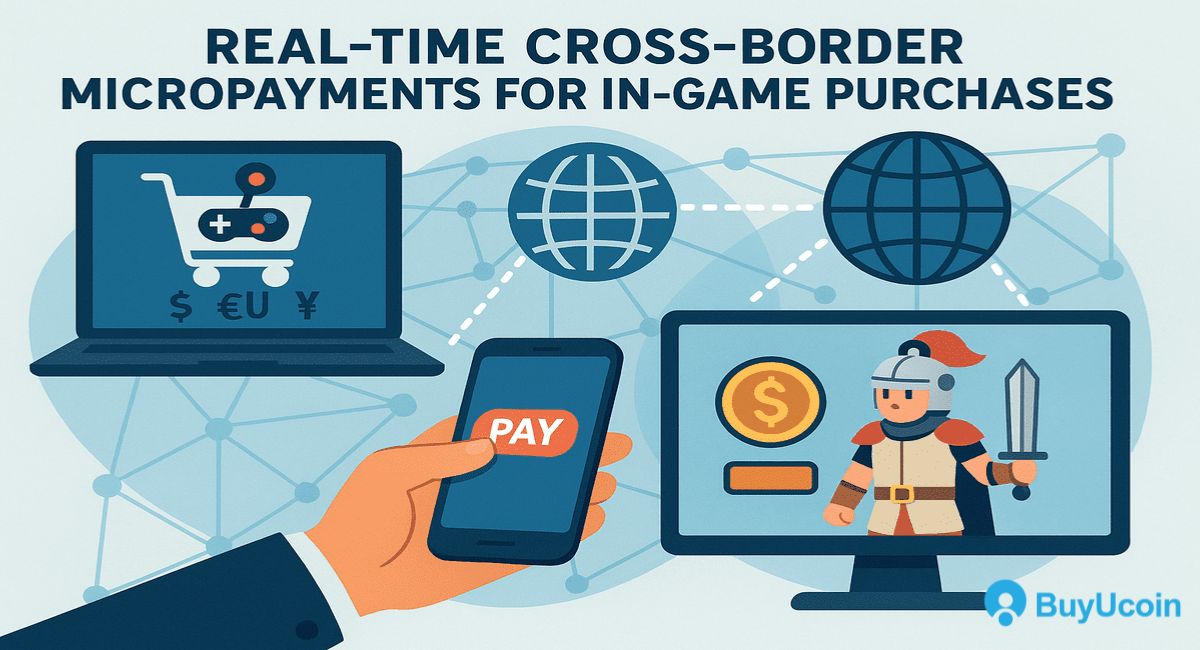
Real-Time Cross-Border Micropayments for In-Game Purchases

In today’s hyperconnected gaming world, cross-border micropayments for in-game purchases are reshaping how players interact with digital economies. As the gaming market crosses $250 billion globally, in-game monetization has moved from one-time purchases to a dynamic stream of microtransactions that occur in real-time, especially across borders.
With increasing international demand, seamless and scalable micropayments have become essential. Yet, managing microtransactions across countries comes with serious challenges—currency volatility, fee structures, regulatory burdens, and slow transaction speeds.
This blog explores how real-time cross-border micropayments for in-game purchases are evolving, the role of crypto and blockchain, and how developers and publishers can ride this wave for growth.
Why Cross-Border Micropayments for In-Game Purchases Matter
Over 60% of gaming revenue in 2024 is driven by in-game microtransactions.
Gamers increasingly purchase across global marketplaces.
The average microtransaction value lies between $0.99 and $4.99, often too small for traditional payment rails to handle efficiently.
A player in India buying a $1 skin in a US-developed game may encounter:
Currency exchange friction,
High flat fees (which outweigh the transaction),
And delays due to cross-border verification systems.
This creates friction, leading to abandoned carts and lost revenue.
Common Challenges in Cross-Border Micropayments
1. Currency Conversion & FX Risks
High volatility in exchange rates can distort the actual value for users.
Sudden changes can affect both publishers and gamers in real-time.
2. Transaction Fees
Traditional payment providers (like Visa, Mastercard) charge fixed and percentage-based fees.
On a $1 transaction, a $0.30 fixed fee plus 2.9% kills profitability.
3. Settlement Delays
Traditional systems may take 24-72 hours to settle cross-border payments.
This delay breaks immersion in real-time gameplay.
4. Regulatory Constraints
AML/KYC laws apply differently per country.
Micropayments still often trigger friction under strict banking rules.
5. Fraud and Chargebacks
Low-value transactions are still targets for chargeback abuse.
Games lack granular fraud prevention for $0.99 purchases.
Traditional Fiat Payment Solutions (and Their Limits)
Local Acquiring
Many games use local PSPs (Payment Service Providers) to manage regional payments:
Brazil (Pix)
India (UPI)
Thailand (PromptPay)
These are fast and cost-effective, but:
Need regional partnerships,
Require compliance with local regulations,
Don’t scale globally without complex integrations.
Prepaid Wallets and Vouchers
Popular in Asia and Latin America, but:
Not real-time,
Hard to reconcile and manage refunds.
Payment Rail | Avg. Transaction Time | Cost (Per $1) | Region Coverage |
Visa/Mastercard | 1-3 days | $0.33 + 2.9% | Global |
UPI | Real-time | ₹0.50-₹1.00 | India |
Pix | Real-time | 0-1% | Brazil |
Crypto (Stable) | Real-time | $0.01-$0.05 | Global |
Why Crypto is a Game-Changer for Cross-Border Micropayments
1. Instant Settlement
Crypto eliminates middlemen and offers near-instant settlement using public blockchains like Solana, Polygon, or the Lightning Network on Bitcoin.
2. Stablecoins Reduce FX Loss
Using stablecoins like USDT or USDC ensures value retention, avoiding unpredictable FX shifts.
3. Low Fees for Micropayments
Unlike fiat processors, crypto allows:
$0.01–$0.05 fees on transactions under $5,
Zero chargeback risk,
Trustless settlements via smart contracts.
4. Global Interoperability
Players can pay in USDC from Nigeria or Thailand and receive the same seamless UX. No need to integrate 20 PSPs.
Developer Tools for Integrating Crypto Micropayments
Must-Have Features:
Instant wallet creation for users
Micro-gas optimization
Webhooks for payment confirmation
Fiat on-ramp/off-ramp integration
Enhancing User Experience Through Real-Time Payments
Smooth UX is everything. Here's how real-time micropayments influence gameplay:
Speed matters: 2–3 second delays = rage quits
Bundle logic: Users are more likely to pay $4.99 for 500 gems than $0.99 for one skin
Currency masking: Let users see in-game units, not fiat/crypto math
Tip:
Gamify payment flows with animation, progress bars, and rewards. More dopamine = more conversions.
Game Monetization: Fiat vs Crypto
Feature | Fiat Payments | Crypto Micropayments |
Settlement Speed | 1–3 days | Instant |
FX Conversion Needed | Yes | No (Stablecoins) |
Chargeback Risk | High | None |
Integration Time | 4–8 weeks per PSP | 1–2 weeks with APIs |
Fee on $1 | $0.33+ | $0.01–$0.03 |
Crypto clearly wins in agility and scalability, especially when targeting emerging markets.
Security & Regulation in Cross-Border Crypto Micropayments
AML/KYC for Sub-$5 Transactions
Many jurisdictions offer thresholds for "micro-KYC":
India: KYC under ₹2,000 (~$24) often relaxed
EU: e-money regulation allows up to €150 without full verification
Smart Contract Security
Use audited contracts for payment handling
Monitor for fraud patterns via blockchain forensics (e.g., Chainalysis, TRM Labs)
Case Study: India’s UPI + Crypto Combo
UPI handles 12 B+ transactions monthly.
Young gamers increasingly use UPI + crypto wallets for hybrid payments.
Platforms like BuyUcoin enable seamless purchases through crypto and UPI.
With low fees and fast confirmation, this combo is ideal for developers looking to maximize Indian gamer monetization.
Emerging Markets to Watch
Region | Micropayment Method | Gaming Trend |
LATAM | Pix + USDT | Mobile F2P Growth |
Southeast Asia | GCash + BUSD | Battle Royale & Esports |
MENA | Wallets + Stablecoins | NFT + AAA Gaming |
Africa | MPesa + Celo/USDT | Hyper-casual / Mobile |
The Future of Cross-Border Micropayments for In-Game Purchases
Trends to Watch:
Cross-chain in-game payments (via bridges and oracles)
Web3 identity for KYC-light onboarding
AI-driven pricing models for individual players
Decentralized marketplaces using smart contract escrows
These innovations are turning simple microtransactions into global, intelligent, and autonomous game economy flows.
Conclusion
Cross-border micropayments for in-game purchases are no longer a “nice-to-have”—they are critical infrastructure for modern gaming success. Crypto-based real-time micropayments are rewriting the rules by reducing friction, slashing fees, and enabling global reach from day one.
Developers, publishers, and gaming platforms that adopt these new payment rails stand to benefit from higher conversions, deeper player engagement, and a truly borderless monetization strategy.
Ready to Supercharge Your In-Game Payments?
Get started today at BuyUcoin.com. Start accepting real-time crypto micropayments with BuyUcoin – India’s best crypto exchange. Seamless UPI integration, stablecoins, and full developer APIs await you. Contact us today or Email us.